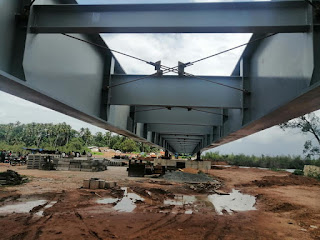Mabang may reopen soon as a two-lane bridge
This weekend on Twitter, Ambrose James, director of Sierra Leone's National Authorising Office, tweeted that the first phase of a 163-meter long steel beam was launched across the Mabang river for a new bridge.
The National Authorising Office-Sierra Leone (NAO), is the principal management and executing agency of the EU-Government of Sierra Leone development cooperation. (See more on the NAO's Facebook page).
The old Mabang bridge collapsed on February 22nd, 2013. Shortly after, a group of concerned Sierra Leoneans in America hired civil and structural engineers to inspect the collapsed bridge.
Based on the 2013 findings, the collapse of the Mabang Bridge was due to extensive scour on the piers of the bridge.
"The foundation of the pillars was also destroyed by impact from eroded soil," the report said. "There were no layers of gravel, sand, and any form of proper anchoring to embed the pillars on the Mabang Bridge. It’s a miracle that the bridge even survived for this period of time."
The report also said floodwaters penetrated the bridge's bearings, and that the area around the fable anchor was not filled with rip rap stones but instead backfilled with mud and topped off with clay.
"As an engineer, I believe that the report either had to have been in existence before the bridge collapsed or that to have produced it within 24 hours of the collapse of the bridge, given how things are in Sierra Leone, is a miracle," Garber said. "I would not think any organization would do a report like that without government authorization. I would be skeptical if an engineer gave me a report on this disaster after 24 hours when you can't get to parts of the collapsed bridge."
Initial reports speculated that up to 34 people were killed. But Sylvia Blyden, the onetime publisher of Awareness Times and executive assistant to former President Ernest Bai Koroma, however, dismissed the claims in a statement posted at Voices of Sierra Leone (VOSL) on Facebook:
"As soon as the news broke on national TV last night that Mabang Bridge collapsed killing 34 people, President Koroma immediately instructed me to send a team up there to the scene. The team arrived at 3 am this morning. According to their initial report, it is true that the bridge collapsed. It is however not true that 34 people died. The initial report says no one died. I am going up there myself shortly as instructed by the President."
"This bridge is the boundary between Koya chiefdom in Port Loko and Rebi chiefdom in Moyamba Districts; from the direction of Waterloo and Songo," wrote Isata Mahoi on VOSL. "It has been a trap for years. The moment a car steps on those timbers they start shaking. I was always afraid to go through that bridge in a car."
Garber expressed similar fears in an article published in Awareness Times. Garber, who was on a trip to find a colonial-era relic, wrote this gripping account about his experience on the Mabang bridge:
"Early the next morning, I set off to see Mabang College. After passing through my hometown of Waterloo, we take the unpaved road leading to Songo and then on to Moyamba. The driver is informed that once we get across the Ribbi River Bridge, we would arrive in the village of Mabang. We eventually arrive at the bridge and have to come to a halt. While the bridge structure itself looked old but sturdy, the driving surface left a lot to be desired and was almost enough to make one consider not going any further with the trip. However, a guide was on hand to precede us across the bridge, arranging the timber planks to ensure they were directly below the wheels. This did not necessarily ease the fears of traversing it and once we were safely across."
More than a dozen January's ago, an IRIN report on Mabang reopening trumpeted the news that the strategic bridge linking Freetown to the Eastern and Southern provinces had been reopened after repairs funded by international donors.
The 203-meter long and 3.5-meter wide bridge had been closed by the RUF [Revolutionary United Front] and army renegades knew as the West Sides Boys. It was remodeled by the Sierra Leone Roads Authority and the former United Nations Mission in Sierra Leone (UNAMSIL), with money from the European Community and the UN World Food Programme.
Tenneh Turay said on VOSL:
"I recall that the [fir]st bridge was a Railway Bridge and tragically an accident occurred on it causing fatalities in the 1960s. The British Ministry of Defence promptly despatched engineers who repaired it and it again became operational. When we stopped using the Railway, motor vehicles started to use it. So in fact it has been in use for over 50 years... I doubt if any regular inspection or maintenance was carried on it or any other bridge for that matter. I do trust that our Chinese friends will help us to build a stronger [and] better structure this time."





Comments